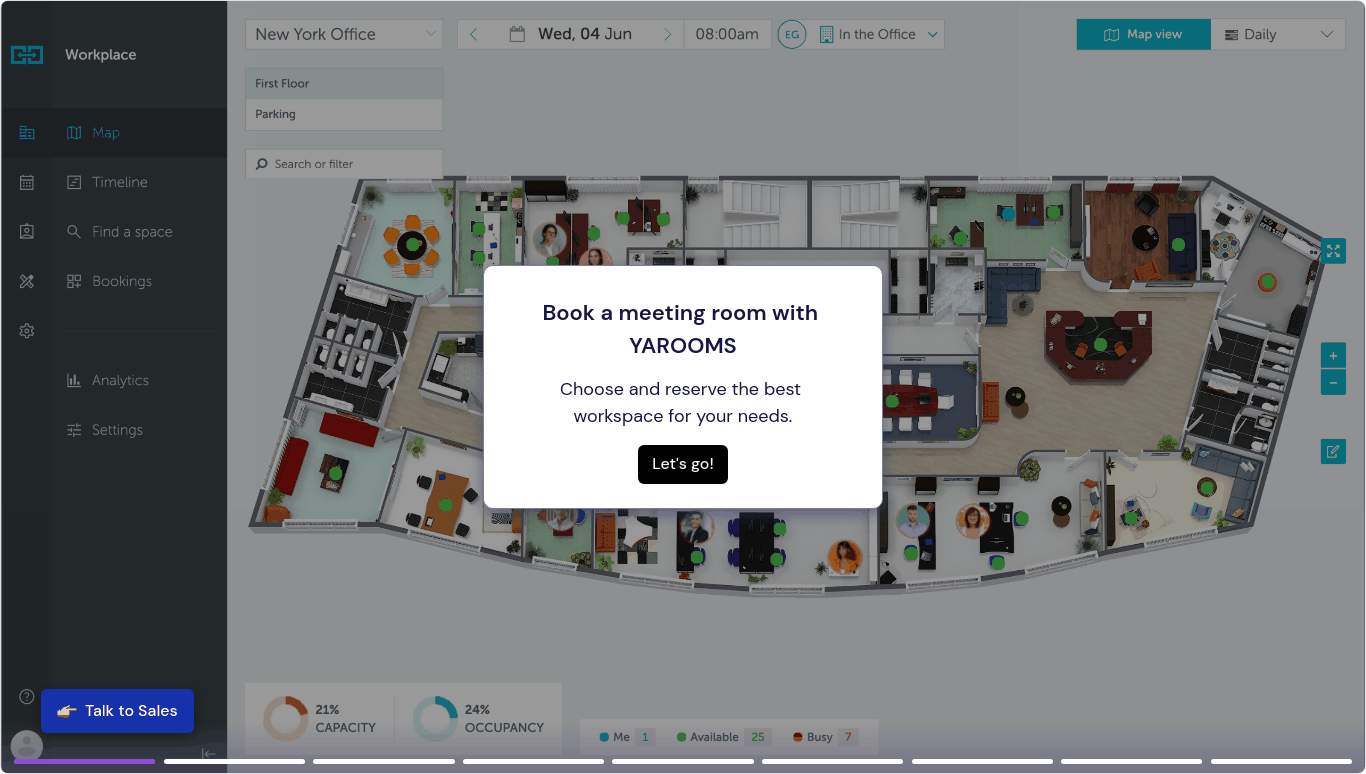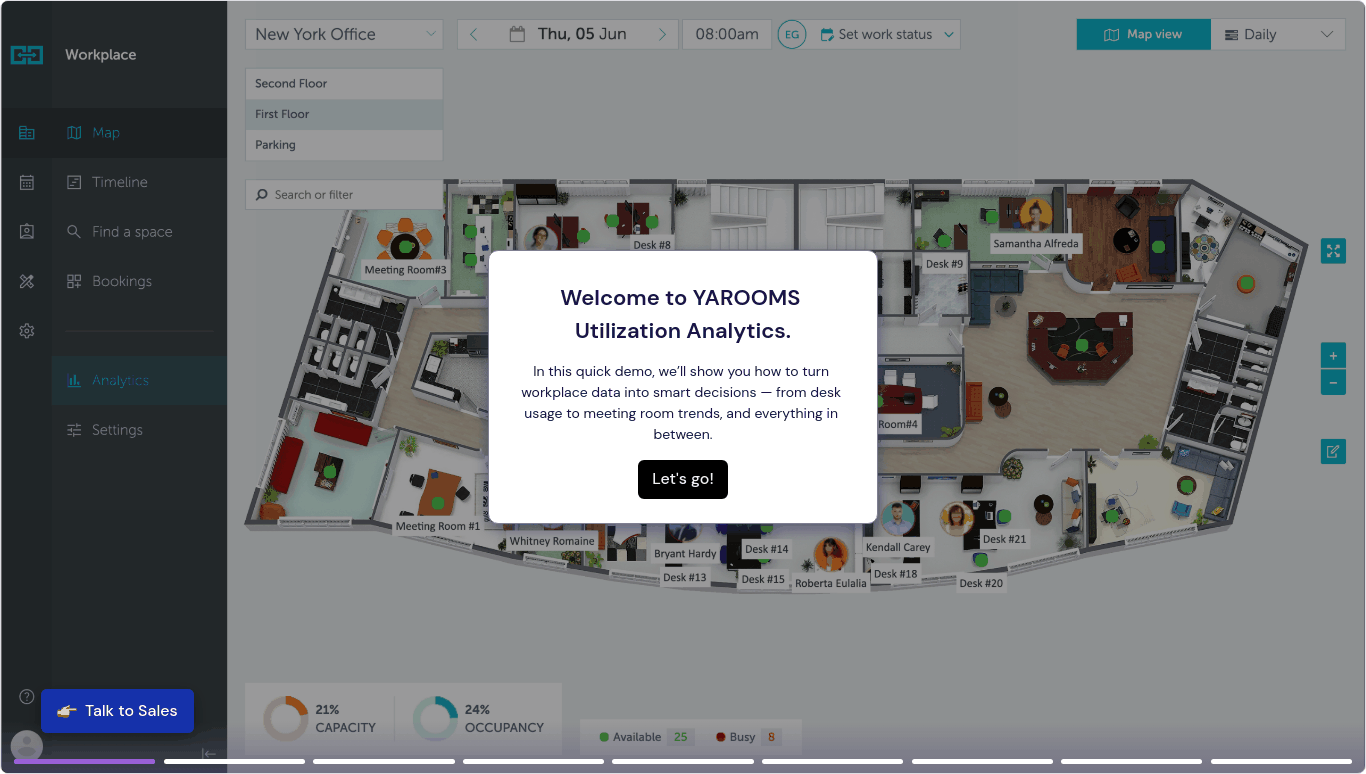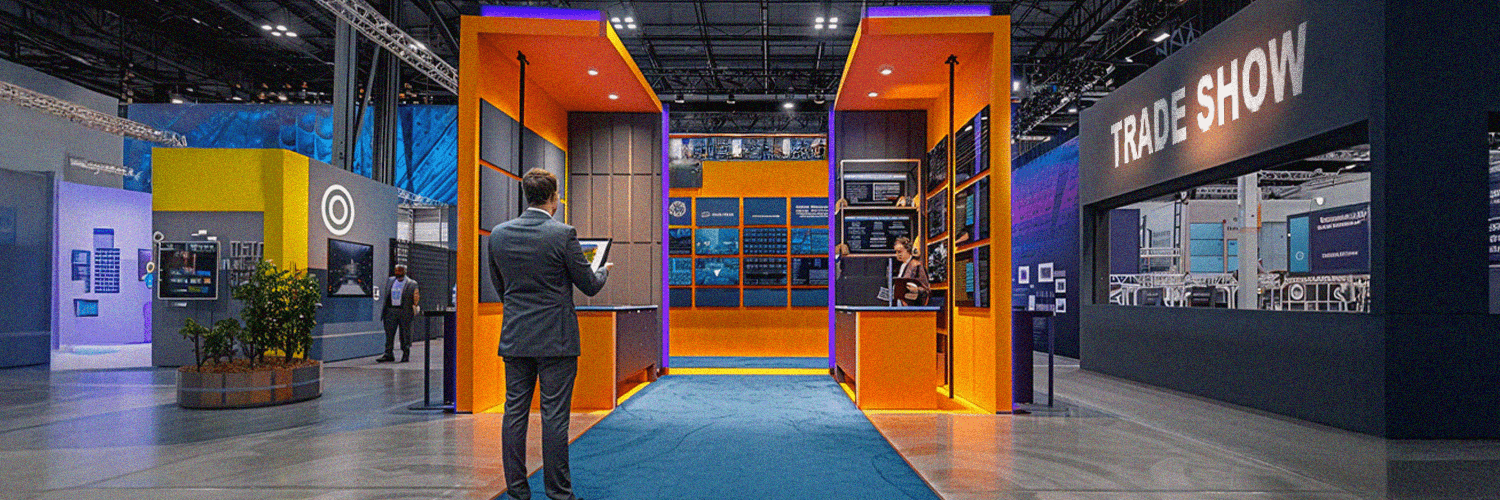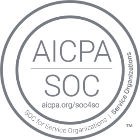[Updated 4 November, 2025]
In today’s fast-changing business landscape, efficiency in the workplace is no longer just about doing things faster - it’s about doing them smarter. An efficient workplace uses time, technology, and resources in a way that maximizes output without burning out people or budgets.
Organizations that focus on improving efficiency in the workplace consistently see higher productivity, stronger employee engagement, and reduced operational costs. In fact, recent studies show that AI-driven tools could contribute up to $4.4 trillion in annual productivity gains worldwide - a clear signal that technology and efficiency now go hand in hand.
But creating efficiency in the workplace requires more than automation alone. It’s about combining streamlined processes, clear communication, and the right digital infrastructure - especially in hybrid environments where collaboration happens across locations and time zones.
This guide breaks down what efficiency means in the workplace, highlights practical ways to improve it, and shares real-world examples, metrics, and AI-driven strategies to help your teams perform at their best.
TL;DR:
-
Efficiency ≠ speed: It’s about using time, technology, and resources smarter — maximizing output without exhausting people or budgets.
-
AI-driven productivity: Intelligent tools could add $4.4 trillion in annual global productivity gains, proving that technology and efficiency in the workplace now go hand in hand.
-
Efficiency matters: Efficient companies enjoy 30–50% higher operating margins, 50% lower space costs, and 15% less burnout among hybrid employees.
-
Key traits of efficient workplaces: clear communication, streamlined processes, flexibility, and data-driven decision-making.
-
How to measure efficiency: Track metrics like productivity rate, workspace utilization, task completion, and revenue per employee.
-
Top strategies to improve efficiency:
-
Modernize outdated procedures
-
Automate repetitive tasks with AI
-
Optimize office space and hybrid work models
-
Enhance visibility with shared maps and schedules
-
Break down departmental silos
-
Invest in integrated, user-friendly technology
-
-
Real-world proof: Companies like Jigsaw Insurance and ASEE improved efficiency and saved over £21,000–€200,000 annually with smart booking and hybrid optimization via YAROOMS.
-
Balance tech with humanity: True efficiency blends automation, flexibility, and employee well-being — creating workplaces that are productive, sustainable, and human-centered.

What Is Efficiency in the Workplace and Why Is It Important?
Efficiency in the workplace means achieving the best possible results with the least amount of wasted time, effort, and resources.
While productivity measures how much work gets done, efficiency focuses on how effectively people, tools, and systems convert effort into outcomes. In other words, it’s the balance between output and input - achieving more with less.
Recent studies reveal that the average employee is productive for just over four hours a day, emphasizing why improving efficiency in the workplace is critical for staying competitive - especially in hybrid work environments where coordination across locations adds new layers of complexity.
Why Efficiency in the Workplace Matters
- Increased productivity: Streamlined workflows help employees focus on high-value tasks. Research from AIHR shows that companies with efficient operations enjoy 30–50% higher operating margins than less efficient peers.
- Cost savings: Better resource efficiency in the workplace means lower operating expenses. Organizations adopting hybrid work models are saving up to 50% on office and real estate costs by reducing unused space and optimizing layouts.
- Higher employee satisfaction: Eliminating unnecessary obstacles improves morale and engagement. Hybrid workers report 15% lower burnout rates than full-time office employees, showing a clear link between efficiency and well-being.
- Competitive advantage: Driving efficiency in the workplace helps organizations respond faster to change, innovate more effectively, and maintain agility in competitive markets.
- Consistent quality: Efficiency is about removing waste while maintaining (or improving) quality. Efficient workflows enhance both speed and accuracy.
- Adaptability to change: Efficient organizations are more flexible and can quickly adjust to new technologies or business priorities - a must in today’s fast-evolving, AI-driven environment.
Characteristics of an Efficient Workplace
Before you can improve efficiency in the workplace, it’s essential to understand what an efficient organization actually looks like.
Truly efficient workplaces combine clear communication, streamlined processes, flexibility, and a culture that empowers people to do their best work with minimal friction.
Clear Communication and Collaborative Culture
Efficiency and productivity in the workplace depend heavily on how information flows. Poor communication wastes time, creates misunderstandings, and reduces alignment across teams.
According to Atlassian, 99% of employees in open offices report being distracted, showing how easily communication can break down without structure. A UC Irvine study found it takes about 20 minutes to regain focus after a single interruption - proof that efficiency relies as much on clarity as on speed.
Effective communication helps to:
-
Establish clear expectations and efficiency goals
-
Reduce redundant work and rework
-
Align departments around shared objectives
-
Ensure everyone understands how their tasks support company outcomes
Intentional communication - through clear channels, documented processes, and accessible tools - is the foundation of creating efficiency in the workplace.
Streamlined Processes and Procedures
Efficient workplaces simplify and systematize how work gets done. Streamlined processes remove unnecessary steps, eliminate bottlenecks, and allow employees to focus on high-value tasks.
Organizations driving operational efficiency in the workplace should regularly audit workflows to identify:
-
Redundant approvals that slow decision-making
-
Manual tasks that could be automated
-
Information silos that block collaboration
-
Repetitive work that adds no measurable value
Applying the 80/20 rule - focusing on the 20% of activities that produce 80% of outcomes - remains one of the most effective ways to improve efficiency in the workplace.
Flexibility and Employee Autonomy
Flexibility has become one of the strongest indicators of efficiency in the workplace.
Recent surveys show that 80% of employees say flexible work improves their quality of life, and about one in three believe it boosts their productivity. That connection between autonomy and output highlights how flexibility directly supports both efficiency and productivity in the workplace.
More than half of corporate workers also report being hindered by excessive meetings and emails, which disrupt deep work and slow progress.
To counter this, the most efficient organizations:
-
Offer flexible schedules that align with personal productivity peaks
-
Focus on outcomes over hours worked
-
Trust employees to self-manage their workflows
-
Provide digital tools that support both remote and in-office collaboration
This combination of trust, structure, and flexibility drives sustainable efficiency and effectiveness in the workplace - helping employees perform at their best while maintaining a healthier work-life balance.

Positive Work Environment
An efficient workplace supports both physical comfort and psychological well-being — two critical drivers of sustained performance.
Physical factors that influence efficiency:
-
Office layouts that balance collaboration and focus zones
-
Ergonomic furniture that prevents fatigue
-
Proper lighting, temperature, and noise control
-
Technology infrastructure that supports uninterrupted workflows
Psychological factors that build efficiency:
-
Recognition programs that reinforce effort and outcomes
-
Mental health and burnout prevention support
-
Trust between leadership and staff
-
Purpose-driven culture that connects daily work to meaningful results
These elements together improve resource efficiency in the workplace, helping teams get more done with fewer setbacks.
Innovation Culture and Calculated Risk-Taking
Driving efficiency in the workplace also requires innovation. Efficient organizations encourage employees to test new ideas, challenge old habits, and share learnings openly.
Companies with a strong innovation culture typically:
-
Dedicate time and budget to test process improvements
-
Celebrate both successes and lessons learned from failure
-
Encourage cross-department collaboration
-
Question “this is how we’ve always done it” thinking
When innovation is treated as a continuous process, efficiency and effectiveness in the workplace naturally improve - not through constant pressure, but through curiosity and adaptability.
Listen to the podcast for practical ideas how to encourage innovation in the workplace
Key Hybrid Workplace Efficiency Metrics
Measuring efficiency in the workplace becomes more complex in hybrid work environments, where employees split their time between home and the office. To maintain productivity and alignment, organizations must track metrics that go beyond simple utilization rates.
Engagement Rates Across Work Modes
As of November 2025, engagement rates remain highest among hybrid employees (35%), followed by fully remote (33%) and in-office workers (27%). This data challenges the assumption that physical presence equals productivity.
By measuring efficiency in the workplace through engagement tracking, companies can see where employees perform best and which work settings (home, office, or hybrid) drive stronger outcomes.
360-Degree Feedback
A 360-degree feedback system collects performance insights from managers, peers, direct reports, and self-assessments. It’s an essential method for evaluating collaboration, communication, and goal achievement across all work modes.
This approach gives leaders a full picture of efficiency and effectiveness in the workplace, identifying both high-performing teams and areas needing support.
Management by Objectives (Goal-Oriented Management)
In hybrid settings, measuring hours worked is less meaningful than measuring results. Through Management by Objectives (MBO), leaders set measurable goals and track completion rates - shifting focus from presence to performance.
This outcome-based approach helps organizations drive efficiency in the workplace by reinforcing accountability and aligning every task with measurable business results.
Planned to Done Ratio
This metric compares how much work was planned versus how much was actually completed. A high planned-to-done ratio indicates strong execution, realistic goal-setting, and consistent performance across hybrid teams.
Tracking this helps detect bottlenecks early — an essential part of improving efficiency in the workplace and maintaining predictable project delivery.
Time Management Productivity
Time management remains one of the best indicators of productivity and efficiency in the workplace. Hybrid employees must balance meetings, deep work, and personal commitments differently depending on location.
Metrics like:
-
Meeting efficiency (how often meetings end with clear outcomes),
-
Focused work time, and
-
Work-life balance indicators
help organizations measure operational efficiency in the workplace while ensuring flexibility doesn’t lead to burnout.
Real Estate Cost Efficiency
As hybrid models mature, real estate efficiency is becoming a key metric for resource efficiency in the workplace. Companies adopting structured hybrid schedules have reported up to 50% savings in office and facility costs, thanks to lower occupancy and smarter space utilization.
Tracking space usage through workplace analytics tools allows businesses to align physical environments with real employee needs - turning unused square footage into measurable savings.

How to Measure Workplace Efficiency
Before you can improve efficiency in the workplace, you need a clear way to measure it.
Accurate metrics allow you to identify bottlenecks, track progress, and connect operational improvements to measurable outcomes.
Here are five proven formulas for measuring efficiency in the workplace:
Basic Productivity Formula
This is the foundation of all efficiency measurement:
Productivity = Output ÷ Input
Example: If a content team produces 10,000 words (output) in 40 hours (input), their productivity equals 250 words per hour. Tracking this over time helps reveal how process changes or tools impact efficiency and productivity in the workplace.
Workspace Utilization Rate
A key metric for resource efficiency in the workplace, this formula measures how effectively physical space is used:
Workspace Utilization Rate = (Number of Employees ÷ Total Workplace Capacity) × 100
Example: A company with 250 employees and space for 300 has an 83.3% utilization rate.
In hybrid environments, this becomes even more valuable for assessing real-time occupancy and optimizing layouts.
Task Completion Rate
To evaluate workflow consistency and identify process bottlenecks:
Task Completion Rate = (Completed Tasks ÷ Assigned Tasks) × 100
This metric can be applied to individuals, teams, or departments. It’s one of the most straightforward ways to improve efficiency in the workplace, as it reveals where projects frequently stall or exceed expectations.
Revenue Per Employee
A high-level indicator linking operational efficiency to financial performance:
Revenue Per Employee = Total Revenue ÷ Number of Employees
Tracking this over time shows whether efficiency improvements translate into tangible business growth. It’s often used by leadership to benchmark efficiency goals in the workplace across departments or locations.
Employee Effectiveness Score
For a more holistic measure of efficiency and effectiveness in the workplace, combine multiple factors into one composite score:
Employee Effectiveness Score = (Quality × 0.5) + (Productivity × 0.3) + (Timeliness × 0.2)
You can adjust the weightings based on your organization’s priorities. This provides a balanced view of individual performance and helps ensure that efficiency improvements don’t come at the expense of quality or timeliness.
💡Quick Takeaway
Calculating efficiency in the workplace is about combining several metrics to understand performance from every angle. By tracking these formulas together, you can create a data-driven foundation for continuous improvement and better decision-making.
9 Strategies for Improving Workplace Efficiency
Now that we've established how to measure workplace efficiency, let's explore nine proven strategies to enhance it, complete with implementation guidance and real-world examples.
#1: Revamp Outdated Workplace Procedures
One of the most effective ways to improve efficiency in the workplace is to review and modernize outdated procedures. Legacy workflows often slow teams down with redundant steps, unclear approvals, and unnecessary manual tasks. By rethinking these systems, you can boost operational efficiency and set the foundation for sustainable productivity gains.
Here’s a step-by-step approach to modernizing your processes:
Step 1: Conduct a Process Audit
Map every stage of your existing workflow to uncover bottlenecks, redundancies, and approval delays. Document how information flows and where tasks typically stall - this is your baseline for improvement.
Step 2: Prioritize for Impact
Apply the 80/20 rule — focus on the 20% of processes that cause 80% of inefficiency. These high-friction points are where you’ll see the biggest improvements first.
Step 3: Redesign with Efficiency in Mind
Simplify workflows by removing duplicate tasks, automating manual ones, and clarifying approval paths. The goal is to achieve efficiency and effectiveness in the workplace - doing more with fewer steps while maintaining quality.
Step 4: Implement and Measure Results
Roll out new procedures gradually and track key metrics (like task completion rate or cycle time). Regularly measure efficiency in the workplace to ensure your changes deliver consistent performance gains.
#2: Streamline Office Space Booking
Poor space management is one of the biggest hidden drains on efficiency in the workplace.
Underused areas lead to frustration, wasted resources, and limited collaboration, especially in hybrid environments where attendance varies daily.
Modern space utilization strategies focus on making every square foot count through data, flexibility, and smart design.
Key ways to improve efficiency in the workplace through better space management:
Data-Driven Space Planning
Use occupancy sensors, booking analytics, and utilization dashboards to understand how your workplace is actually used — not how it was designed to be used. This data-driven approach supports smarter allocation decisions and reveals underutilized areas that can be repurposed.
Simplified Booking Processes
Adopt user-friendly desk and meeting room booking systems to eliminate scheduling conflicts and reduce time wasted searching for available spaces. Streamlined access to workstations directly increases productivity and efficiency in the workplace.
Flexible Space Configuration
Design adaptable layouts that can easily shift between focused work and collaboration zones.
This kind of agility is central to creating efficiency in the workplace - maximizing space utility while meeting evolving team needs.
With the YAROOMS Workplace Management Platform, organizations can reserve meeting rooms and desks effortlessly while tracking usage in real time. These insights drive operational efficiency, ensuring that no area sits idle while other teams compete for space.
See how YAROOMS desk and room booking works - click the image below for a quick demo. ⬇️
#3: Leverage Workplace Data & Analytics
The most efficient organizations make decisions based on facts, not assumptions. By analyzing workplace data and analytics, businesses gain real-time visibility into how people use spaces, collaborate, and perform - unlocking powerful opportunities to improve efficiency in the workplace.
A data-driven approach enables leaders to refine operations, reduce costs, and align work environments with actual employee needs.
Key areas where workplace analytics drive efficiency and productivity:
Space Utilization Patterns
Workplace data reveals underused areas that can be repurposed and overcrowded spaces that create friction. Tracking utilization over time helps facility managers enhance resource efficiency in the workplace while avoiding unnecessary real estate costs.
Collaboration Networks
Analytics uncover which teams or departments work together most frequently, informing smarter layout and seating decisions. This improves operational efficiency in the workplace by placing interconnected teams closer together - minimizing lost time and communication lag.
Peak Usage Times
By mapping occupancy data, organizations can identify high-demand hours and days. This allows them to optimize cleaning schedules, maintenance, and meeting room availability - measurable ways to increase efficiency in the workplace through better planning.
Employee Preferences
Behavioral data shows how employees prefer to work — quiet zones vs. collaboration hubs, in-office vs. remote. Aligning environments with these insights not only enhances engagement but also supports sustained efficiency and productivity in the workplace.
This evidence-based decision-making helps facility and HR leaders balance cost pressures with performance needs. In fact, Stanford University research found that hybrid work has a neutral effect on productivity and career advancement while reducing resignations by 33% — proving that data-informed hybrid work strategies directly support both employee retention and workplace efficiency.
Discover YAROOMS Workplace Analytics - click on the media for a self-guided demo. ⬇️
#4: Ensure Workplace Visibility for Everyone
In hybrid and distributed work models, visibility - knowing who’s working where and when - is essential for maintaining efficiency and productivity in the workplace.
Lack of visibility leads to scheduling conflicts, missed connections, and wasted time tracking down colleagues. Transparent systems remove that friction, allowing teams to collaborate effectively no matter where they work.
Interactive Office Maps
Digital floor plans help employees quickly locate teammates, resources, and available meeting spaces. This improves operational efficiency in the workplace by reducing time lost to coordination and navigation.
Team Availability Dashboards
Shared dashboards and calendars show who’s in the office versus working remotely. These tools make it easier to plan collaborative sessions, prevent overbooking, and increase efficiency in the workplace through smarter scheduling. Additionally, you may use time off tracking software to see who’s unavailable due to vacations or leave, helping teams plan their workloads.
Hybrid Work Scheduling Tools
Transparent scheduling systems coordinate in-office days across teams to make face-to-face time more intentional and productive. This kind of visibility helps create efficiency in the workplace, ensuring office attendance aligns with collaboration goals rather than chance.
Organizations using workplace visibility software consistently report fewer scheduling conflicts, more productive meetings, and smoother cross-team communication - all major drivers of efficiency in the workplace.
Implementation Example: Hybrid Coordination System
A multinational consulting firm implemented a hybrid coordination system that allowed employees to see when team members planned to be in the office. They introduced shared “collaboration days” on Tuesdays and Thursdays, where most team members were co-located, while still allowing flexible work arrangements.
Results:
-
40% increase in productive, in-person collaboration sessions
-
25% reduction in meeting reschedules
-
Employees reported higher satisfaction with office days and better overall time planning
#5: Embrace Flexible Working
Flexible working arrangements have evolved from a perk into a cornerstone of efficiency and productivity in the workplace. Research shows that flexibility significantly boosts output by allowing employees to work during their most productive hours and in environments that best fit their needs.
To truly improve efficiency in the workplace, flexibility must be structured, transparent, and supported by the right tools.
Clear Output Expectations
Shift focus from hours worked to results achieved. Establish measurable deliverables, timelines, and quality standards so that accountability remains consistent regardless of where employees work. This outcome-oriented approach promotes efficiency and effectiveness in the workplace without micromanagement.
Hybrid Work Schedules
Define which tasks are best suited for in-office collaboration versus remote, focused work.
Structured hybrid schedules help create efficiency in the workplace by aligning activities with the environments where they’re most effective.
Communication Protocols
Clarify how and when team members should connect across locations. Set expectations for meetings, response times, and synchronous collaboration to maintain operational efficiency in hybrid workplaces.
Technology Support
Provide every employee with secure, reliable access to the tools they need — from project management and video conferencing to booking systems and analytics. This digital foundation ensures everyone can perform efficiently, anywhere.
By addressing these four areas, organizations can achieve the efficiency benefits of flexible work while maintaining team cohesion and shared purpose.
Implementation Example: Structured Flexibility Model
A marketing agency introduced a structured flexibility framework after analyzing which activities benefited most from in-person collaboration versus remote focus:
-
In-office: Creative brainstorming, project kickoffs, client presentations
-
Remote: Content creation, design work, research, data analysis
They also defined core collaboration hours (10 a.m.–3 p.m.) when everyone was available for real-time communication.
Results after six months:
-
22% increase in project completion rates
-
Maintained or improved quality standards
-
Stronger alignment across distributed teams
This case proves that flexibility, when structured intentionally, enhances efficiency rather than undermining it, creating a workplace that’s both productive and sustainable.
#6: Automate Repetitive Tasks with AI and Workflow Tools
Automation represents one of the highest-impact ways to improve efficiency in the workplace.
According to McKinsey, 60% of all jobs involve at least 30% of automatable activities - revealing enormous potential to save time, reduce errors, and reallocate employee effort to higher-value work.
Why Automation Matters for Workplace Efficiency
Manual processes - from scheduling to approvals and reporting - often create invisible drag on productivity. By using AI and automation tools, organizations can eliminate repetitive tasks, minimize human error, and improve operational efficiency in the workplace. This doesn’t replace human judgment; it enhances it by freeing people to focus on creativity, analysis, and collaboration.
How AI Improves Efficiency in the Workplace
AI-driven systems can process large volumes of data faster and with higher accuracy than manual methods.
In the context of workplace management, AI efficiency often looks like:
-
Automatically assigning resources (desks, meeting rooms, equipment) based on availability
-
Predicting space or meeting room demand
-
Flagging underutilized assets or time blocks
-
Streamlining workflows through integrations across HR, facilities, and IT systems
These smart automations drive measurable gains in productivity and efficiency in the workplace, particularly in hybrid and large-scale office environments.
Space Booking Automation Case Study: Jigsaw Insurance
Jigsaw Insurance transformed its workplace operations by replacing manual Excel-based space planning with the YAROOMS automated booking system. This upgrade improved both flexibility and cost efficiency - delivering quantifiable savings equivalent to one full-time team leader, or approximately £21,000-£23,000 per year.
Beyond the numbers, automation gave Jigsaw’s teams the freedom to focus on strategic priorities rather than administrative tasks - a direct example of using technology to improve efficiency in the workplace.
#7: Break Down Departmental Silos to Drive Efficiency
Breaking down silos between departments creates some of the biggest opportunities for improving efficiency in the workplace.
When teams operate in isolation, they often duplicate work, delay decisions, and miss chances to combine expertise. By contrast, cross-functional collaboration connects the dots between people, processes, and data - strengthening both efficiency and productivity in the workplace.
This is especially valuable in hybrid organizations, where departments like Human Resources, Facilities, and IT shape the overall workplace experience. When these teams align, operational decisions become faster, smarter, and more strategic.
For example:
-
When HR understands space utilization data from Facilities, they can make more informed decisions about hiring and seating allocation.
-
When IT collaborates with Facilities on workplace technology, adoption rates improve, downtime decreases, and support requests drop.
Shared Goals
Define common objectives that cut across departmental lines. For instance, a shared goal to “reduce office underutilization by 20%” engages both Facilities (space data) and HR (attendance policies).
This alignment ensures all departments move toward the same efficiency goals in the workplace.
Regular Cross-Functional Meetings
Hold structured meetings between departments to share updates, surface issues early, and coordinate upcoming changes.
These sessions accelerate decision-making and support operational efficiency in the workplace.
Integrated Systems
Ensure data flows seamlessly between tools used by different departments - HR systems, space management platforms, and IT asset trackers.
Integrated data ecosystems help create efficiency in the workplace by reducing manual reporting and preventing conflicting information.
Joint Decision-Making
Include all relevant teams when defining workplace policies or adopting new tools.
This cross-departmental ownership prevents efficiency gains in one area from creating bottlenecks in another.
Together, these practices promote a holistic approach to efficiency, ensuring every department contributes to a connected, frictionless, and data-driven workplace experience.
#8: Optimize Office Space for Cost and Resource Efficiency
Contrary to what many assume, downsizing office space can actually increase workplace efficiency.
The key lies in aligning physical space with actual utilization patterns and evolving hybrid work requirements. Rather than being a constraint, a smaller, smarter office can become a driver of operational efficiency in the workplace.
Case Study: ASEE - Hybrid Space Optimization
ASEE provides a clear example of how data-driven workplace management boosts both efficiency and savings.
By transitioning to a hybrid work model supported by YAROOMS, ASEE optimized its Bucharest office footprint and achieved significant financial efficiency, saving approximately €200,000 annually in rent and maintenance costs.
This result mirrors broader industry trends: organizations adopting hybrid work strategies report an average 50% reduction in office space costs through flexible layouts and reduced on-site attendance.
In short, resource efficiency in the workplace often means doing more with less space, not less productivity.
Steps for Efficient Office Space Optimization
-
Analyze space utilization data to see how and when employees actually use the office.
-
Identify peak and low-usage patterns to determine the true space requirement.
-
Redesign remaining space to better support collaboration, focused work, and social connection.
-
Implement flexible booking systems (like desk and room booking platforms) to maximize utilization.
-
Continuously monitor and refine space plans based on evolving work habits and attendance patterns.
By following these steps, organizations can transform their offices into efficiency enablers rather than cost centers - freeing up capital to invest in other productivity-enhancing initiatives.

#9: Invest in Integrated & User-Friendly Technology
Technology should accelerate efficiency, not create new barriers.
Yet many organizations unintentionally slow down operations by introducing tools that are poorly integrated, overly complex, or disconnected from real user needs.
The result? Fragmented workflows, duplicate data entry, and frustrated employees - all of which undermine efficiency and productivity in the workplace.
The most efficient workplaces prioritize integrated, user-friendly ecosystems where information flows automatically between systems. This seamless integration removes manual steps, prevents data silos, and strengthens operational efficiency in the workplace. At the same time, ease of use is non-negotiable - even the most advanced solution fails if employees can’t or won’t use it effectively.
User Involvement
Involve end-users early in the technology selection and configuration process. Their input helps ensure that tools match real workflows, reducing the risk of adoption barriers and ensuring technology truly improves efficiency in the workplace.
Integration Planning
Before implementation, map how data should flow between systems. Plan integrations carefully to avoid disconnected tools and redundant processes - two of the biggest enemies of creating efficiency in the workplace.
Adoption Support
Offer comprehensive onboarding, self-service guides, and ongoing training. Continuous support not only builds confidence but ensures sustained use, which directly contributes to improving efficiency in the workplace.
Performance Measurement
Track key metrics — such as task completion speed, error rates, and time saved - against pre-implementation baselines. These insights show whether the new technology is delivering its promised efficiency and productivity gains or needs adjustment.
When thoughtfully deployed, integrated and intuitive technology becomes one of the most powerful levers for driving efficiency in the workplace -aligning people, processes, and data into a single, frictionless system.
Productivity vs. Efficiency: Understanding the Difference
While often used interchangeably, productivity and efficiency represent distinct concepts that organizations must understand to optimize their workplace performance:
|
Aspect |
Productivity |
Efficiency |
|
Definition |
The total output produced within a given timeframe |
The ratio of output achieved compared to resources invested |
|
Focus |
Volume of work completed |
Optimization of resources used to complete work |
|
Measurement |
Units produced, tasks completed, revenue generated |
Resource utilization, cost per unit, quality-to-effort ratio |
|
Example |
A team produces 50 reports in one week |
A team produces 50 high-quality reports using 30% fewer labor hours than standard |
|
Limitation |
High productivity with excessive resource use may not be sustainable |
May sacrifice speed for resource optimization in some contexts |
The most successful organizations recognize that maximizing both productivity and efficiency requires finding the optimal balance between output volume and resource optimization. This balanced approach prevents the common pitfall of pursuing productivity at the expense of quality, employee well-being, or long-term sustainability.
The Impact of Technology on Workplace Efficiency
Technology has fundamentally transformed how work gets done, creating unprecedented opportunities for efficiency improvements across all business functions.
Automation and AI-Powered Process Improvements
The automation landscape has advanced rapidly - evolving from simple rule-based tools to intelligent, AI-driven systems capable of handling complex workflows.
According to McKinsey, the long-term opportunity for AI in the workplace is valued at $4.4 trillion in potential productivity growth from corporate use cases.
Practical applications include:
-
Document Processing: AI tools can extract, classify, and process information from unstructured documents, reducing manual handling time by up to 80%.
-
Customer Service: Intelligent chatbots manage routine inquiries, allowing human agents to focus on complex or high-empathy cases.
-
Data Analysis: AI systems detect patterns and anomalies across massive datasets, surfacing insights that would take humans days to uncover.
-
Administrative Tasks: Scheduling assistants, automated expense reporting, and AI-generated summaries eliminate repetitive, manual work.
- Smart Space Booking: With tools like the YAROOMS YARVIS AI Assistant, employees can instantly find and book the most suitable desk or meeting room based on preferences, availability, and usage data. YARVIS uses natural language commands and predictive insights to simplify booking decisions, reduce scheduling friction, and improve operational efficiency in the workplace.
These tools don’t just save time - they improve accuracy, consistency, and scalability, delivering better results with fewer resources. This is where AI efficiency in the workplace becomes a tangible reality: faster outcomes, reduced costs, and enhanced decision quality.
YARVIS AI Workplace Assistant
Mobile Technology and Workplace Flexibility
Mobile workplace technology has transformed efficiency and productivity by disconnecting work from a single location. Employees can now collaborate, access data, and complete tasks anytime, anywhere — empowering a more agile and responsive work culture.
Key efficiency benefits include:
-
Eliminated Downtime: Work continues seamlessly during commutes, travel, or between meetings.
-
Real-Time Collaboration: Teams communicate and make decisions instantly, without waiting for in-person syncs.
-
Contextual Work: Employees complete tasks in the most suitable environment, enhancing focus and creativity.
-
Continuous Workflow: Approvals and updates happen asynchronously across time zones, keeping projects moving without delays.
The result is a fluid, always-connected workplace where progress isn’t limited by geography or time - a defining trait of modern technology and efficiency in the workplace.

Challenges to Workplace Efficiency
Despite the clear benefits of improved workplace efficiency, organizations often encounter significant obstacles to implementation. Understanding and proactively addressing these challenges is essential for successful efficiency initiatives.
Employee Burnout and Well-being
Pursuing efficiency without considering human factors can lead to counterproductive outcomes. With 43% of office workers currently reporting burnout, organizations must balance optimization efforts with well-being considerations.
The hybrid work model offers one solution to this challenge. Research shows that hybrid workers experience 15% less burnout than full-time in-office colleagues, indicating improved well-being and potentially more effective teamwork.
Effective approaches include:
- Sustainable Workloads: Setting realistic expectations that recognize human limitations
- Recovery Time: Building deliberate breaks into workflows to allow for mental replenishment
- Mental Health Support: Providing resources to help employees maintain psychological well-being
- Meaningful Work: Connecting efficiency improvements to purpose, not just productivity metrics
Organizations that successfully balance efficiency and well-being enjoy sustainable performance improvements rather than short-term gains followed by turnover and disengagement.
Change Resistance
Resistance to change represents one of the most common barriers to improved workplace efficiency. Employees comfortable with existing processes may view changes as threats rather than improvements, regardless of the potential benefits.
To overcome this challenge:
- Involve Employees: Give staff a role in shaping changes that affect their daily work
- Communicate Purpose: Clearly explain why changes are necessary and how they benefit both the organization and individuals
- Start Small: Begin with pilot projects that demonstrate value before broader implementation
- Celebrate Wins: Recognize and reward early adopters and successful transitions
By addressing the human aspects of change management, organizations can accelerate adoption of efficiency improvements and reduce implementation friction.
Technology Integration Issues
Even the most promising efficiency technologies can fail to deliver results if poorly integrated into existing workflows. Common pitfalls include:
- Siloed Systems: Applications that don't share data, requiring manual transfers and duplicate entries
- Overly Complex Interfaces: Tools that require extensive training and have steep learning curves
- Feature Misalignment: Solutions designed for different contexts that don't address specific organizational needs
- Inadequate Support: Insufficient resources for troubleshooting and ongoing optimization
To avoid these issues, organizations should conduct thorough needs assessments before selecting new technologies, prioritize integration capabilities, involve end-users in selection decisions, and provide robust implementation support.
Skills and Training Gaps
Efficiency improvements often require new capabilities that existing staff may not possess. Without addressing these skill gaps, even the best-designed initiatives will struggle to deliver results.
Effective skill development approaches include:
- Targeted Training Programs: Focused learning opportunities tied directly to specific efficiency initiatives
- Peer Learning Networks: Structures that allow employees to share knowledge and best practices
- Just-in-Time Resources: Reference materials and support tools available at the moment of need
- Recognition of Learning: Acknowledging and rewarding skill development to motivate continuous improvement
By investing in capability building alongside process and technology changes, organizations ensure their workforce can fully leverage efficiency opportunities.

Final Thoughts: Balancing Workplace Efficiency with Humanity
True efficiency in the workplace isn’t achieved by technology or processes alone—it’s powered by people.
The most effective organizations understand that improving efficiency means optimizing systems and supporting the humans who use them. When people and technology move in sync, efficiency becomes sustainable rather than short-lived.
Recent data underscores this balance:
-
66% of executives say that requiring employees to return to the office hasn’t improved productivity, proving hybrid work doesn’t weaken collaboration.
-
90% of CEOs link cost reductions directly to hybrid models—much of it driven by smarter space utilization and resource efficiency in the workplace.
Efficiency, therefore, should serve a purpose beyond speed or cost-cutting. The real goal is to create a work environment where employees can perform at their best, connect meaningfully with their teams, and contribute to lasting organizational success.
As you refine your own efficiency improvement strategies, keep these principles in focus:
-
Involve the people affected by every process change.
-
Measure outcomes that truly matter, not just activity levels.
-
Address root causes of inefficiency instead of temporary fixes.
-
Balance resource optimization with employee well-being.
The future of work will continue to evolve in the upcoming 2026 - driven by AI, data, and flexibility - but the foundations of effective and humane efficiency will remain constant.
Organizations that align technology, purpose, and empathy will create workplaces that are not only efficient but also engaging, resilient, and sustainable, delivering long-term value for employees, customers, and stakeholders alike.
FAQ: Workplace Efficiency
How to Improve Organizational Efficiency?
To improve organizational efficiency, focus on simplifying workflows, aligning teams, and using technology to eliminate wasted effort.
Start by auditing existing processes to identify bottlenecks, then redesign them around clarity, automation, and measurable goals.
Key actions include:
-
Automate repetitive tasks with AI and workflow tools to reduce manual work.
-
Encourage collaboration between HR, IT, and Facilities to break down silos.
-
Use workplace analytics to make data-driven decisions about resources and space utilization.
-
Adopt integrated technology to streamline bookings, communication, and reporting.
-
Set clear performance metrics so every team understands how efficiency is measured and improved.
When supported by transparent leadership and user-friendly systems, these steps create sustainable efficiency and productivity in the workplace, helping organizations achieve more with less effort and greater clarity.
What Are Some Examples of Efficiency in the Workplace?
Examples of efficiency in the workplace show how teams save time, reduce costs, and improve outcomes without sacrificing quality.
Common examples include:
-
Automated space booking: Using tools like YAROOMS YARVIS AI Assistant to instantly reserve desks or meeting rooms, eliminating scheduling conflicts.
-
Workflow automation: Automating repetitive tasks such as report generation, data entry, or expense processing to free up employee time.
-
Hybrid work optimization: Using data to right-size office space and reduce real estate costs by up to 50%.
-
Cross-department collaboration: HR, IT, and Facilities sharing data to align hiring, tech access, and space management.
-
Flexible scheduling: Allowing employees to work during peak productivity hours—boosting engagement and reducing burnout.
-
Data-driven decision-making: Using analytics to track space utilization, task completion rates, or project turnaround times for measurable efficiency gains.
These examples of improving efficiency in the workplace demonstrate how a mix of smart processes, automation, and flexibility can deliver higher productivity with fewer resources.
What Are Some Professional Office Enhancements for Efficiency?
Professional office enhancements that improve efficiency in the workplace combine smart design, technology, and process optimization to help teams work better and faster.
Top enhancements include:
-
Ergonomic furniture and layouts that reduce strain and support focused work.
-
Open yet balanced floor plans with dedicated collaboration zones and quiet areas.
-
Digital room and desk booking systems like YAROOMS, to eliminate scheduling conflicts and improve space utilization.
-
Automated lighting and climate controls to boost energy efficiency and comfort.
-
Integrated communication tools for seamless collaboration across remote and in-office teams.
-
Acoustic and lighting upgrades that minimize distractions and enhance concentration.
-
Workplace analytics dashboards that track usage, occupancy, and performance metrics.
These professional upgrades create a smarter, data-informed environment, driving both productivity and efficiency in the workplace while improving employee satisfaction.
What Causes Low Efficiency in the Workplace?
Low efficiency in the workplace usually stems from a mix of poor processes, unclear communication, and outdated systems.
Common causes include:
-
Inefficient workflows with redundant approvals or manual steps.
-
Lack of communication leading to confusion, rework, or duplicated efforts.
-
Outdated or disconnected technology that slows down daily tasks.
-
Low employee engagement due to unclear goals or limited autonomy.
-
Poor space management, such as overcrowded offices or underused meeting rooms.
-
Insufficient training on tools, processes, or time management.
-
Over-scheduling and unnecessary meetings that disrupt focus time.
Addressing these issues through better tools, streamlined procedures, and data-driven decision-making can dramatically improve efficiency and productivity in the workplace.













